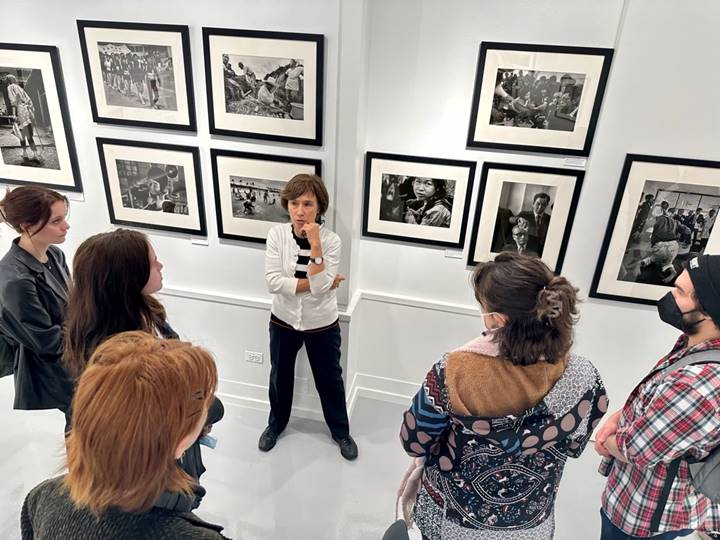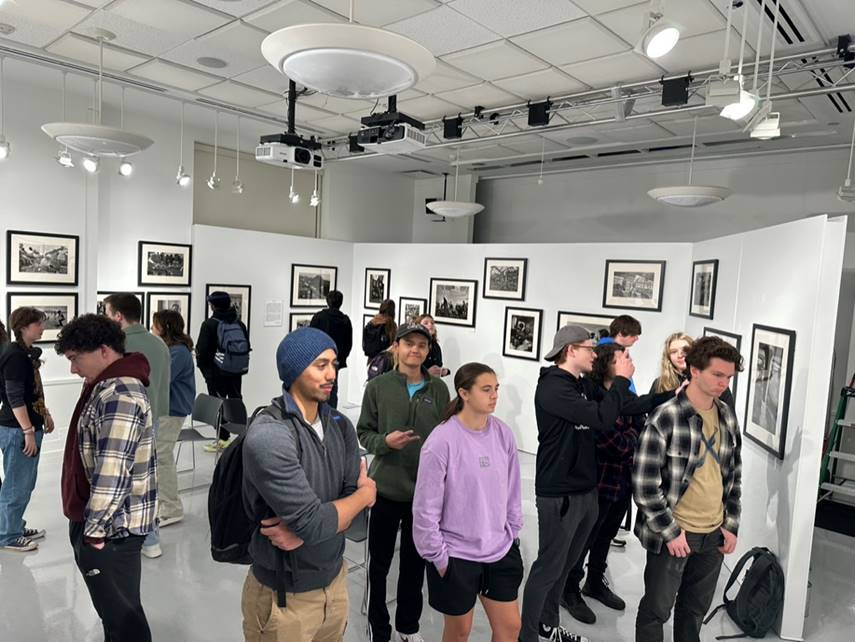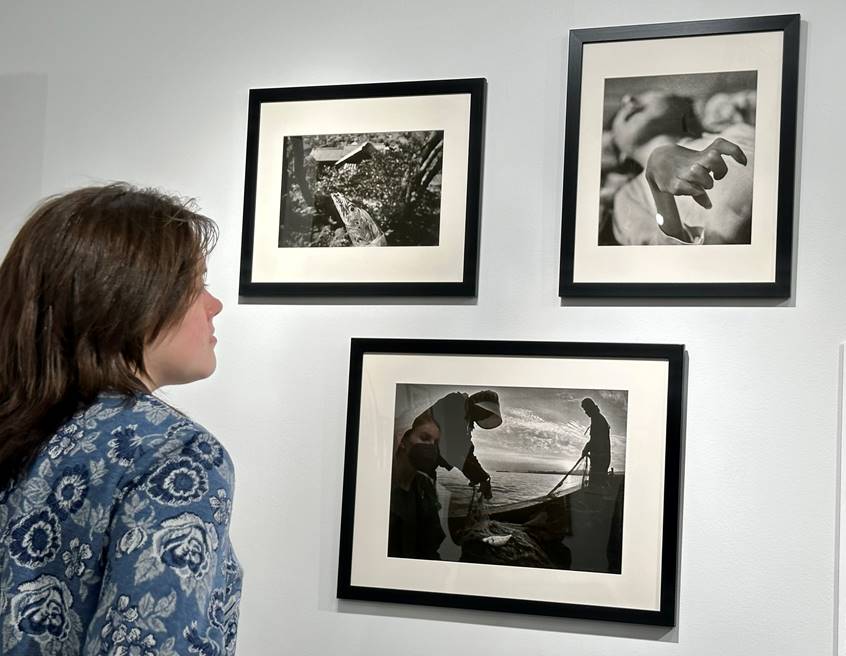
Aileen Mioko Smith speaks with photojournalism students about how she and her then husband, W. Eugene Smith, documented mercury poisoning in Minamata, Japan. (Photo by Robin Hoecker)

Discover Chicago students visiting the Minamata exhibit. (Photo by Robin Hoecker)

Photojournalism student L.K. Tooley looks at the opening panel of the Minamata exhibit. (Photo by Robin Hoecker)

Left to Right: Robin Hoecker, Quentin Blais and Aileen Mioko Smith standing in front of Blais' photo story about lead toxicity in Chicago's soil. (Photo courtesy of Robin Hoecker)
Across the world, many communities are still affected by an environmental disaster that began nearly 100 years ago in a small fishing village in Kumamoto Prefecture, Japan. A plastics factory operated by Chisso dumped wastewater into the bay of the fishing and industrial community for over 30 years, contaminating the surrounding water with methylmercury. The result was a community that was ravaged by an illness eventually named after the village, Minamata disease.
Now, DePaul is hosting a photo exhibition that ties the environmental disaster in Japan with environmental disasters closer to home in Chicago. The world-renowned work of photojournalists W. Eugene Smith and Aileen Mioko Smith is on display alongside work by College of Communication students. Robin Hoecker, an assistant professor of journalism, curated the exhibition in collaboration with the DePaul Humanities Center, and it is on display in the John T. Richardson Art Gallery through Nov. 16.
A disaster in a Japanese village
Consuming methylmercury through contaminated water and fish led to Minamata residents experiencing severe issues in the central nervous system, with increased severity in children who had been exposed to methylmercury in the womb.
After years of being ignored, the world took notice in part thanks to the work of the Smiths, who documented the effects of methylmercury poisoning and supported victims in Minamata as they fought for recognition, compensation and to stop the pollution. The attention eventually led to stricter regulation of industrial pollution in Japan.
“We never intended to stay very long, but these events kept unfolding and we followed them,” Aileen Mioko Smith said when she visited the exhibition at DePaul in October. “The victims rose up and decided to fight to hold the company legally responsible for having caused this damage. These were people that were very assertive, that wanted and needed the world to know what they were going through.”
The Smith’s photographs were originally published as a photo essay in Life magazine in 1972, sharing the effects of mercury poisoning with the world.
The impact of images
With many Minamata victims still fighting for legal recognition and new symptoms developing as they age, the impact of Chisso’s pollution and other instances of environmental pollution are still felt to this day. Although W. Eugene Smith has passed away, Aileen Mioko Smith continues to share their work and the stories of the Minamata victims through exhibitions and advocacy. She believes photography is critical to bringing attention to issues and enacting change.
“In order to solve any problem, your heart has to be touched,” she says. “In the photographs you see not just the terrible pollution and its effects, but also what people did in response and the success victims were able to have. Seeing some portion of justice is really empowering.”
For Hoecker, the power of photography is something she reminds her students about constantly.
“Humans are visual creatures. Photos focus our attention to what’s important and help us understand issues in ways that words often cannot,” she says.
Aileen Mioko Smith continues to work in activism, bringing attention to a series of different issues including pollution, climate change and nuclear evacuation. In this work, she finds that there are many intersections between the issues of reducing mercury pollution and climate change, such as coal-fired plants and fluorescent lights.
“The gold and fossil fuel industries are the primary bad actors. Coal-fired plants emit mercury into the atmosphere which falls back into the land and ocean, affecting plants, fish and people,” she says.
From Minamata to Chicago
The images displayed in the Richardson Art Gallery depict issues that affect audiences today, despite many of the photos being taken half a century ago.
“There are universal themes in the Minamata photographs about power, greed and justice that remain relevant to us in Chicago in 2023,” Hoecker says. “We still have environmental pollution here and communities calling for policy changes and justice.”
This connection through time and space is woven into the exhibition through the inclusion of photographs from DePaul students covering issues of pollution in Illinois. Journalism student Quentin Blais shares a story about lead toxicity in soil, and alumnus Richie Requena writes about monitoring air pollution in Cicero. Both stories remind visitors to be aware of any pollution in their own neighborhoods. Visitors are also invited to upload their own photographs related to local pollution.
According to Yuki Miyamoto, director of the DePaul Humanities Center, this exhibition is an example of international and community collaboration for social justice.
“This issue in Minamata is not over yet. It is important to bring awareness of it here and connect it to Chicago because they are structurally connected,” Miyamoto says.
Aileen Mioko Smith agrees: “It is important to remember that these issues are local, right around you. If people work together with their communities to clean up the surrounding environment, that really makes a change.”
The exhibition will be open from 1-5 p.m. on Tuesdays, Wednesdays and Thursdays through Nov. 16. The Richardson Art Gallery is located on the first floor of the John T. Richardson library near the 2350 N. Kenmore Ave. entrance.
Jade Walker is a student assistant of media relations and communications in University Communications.